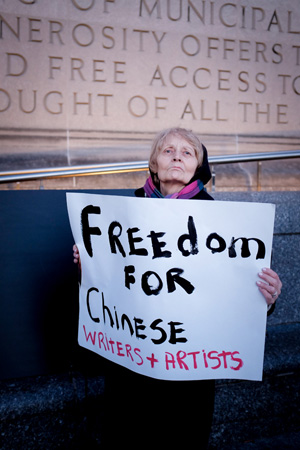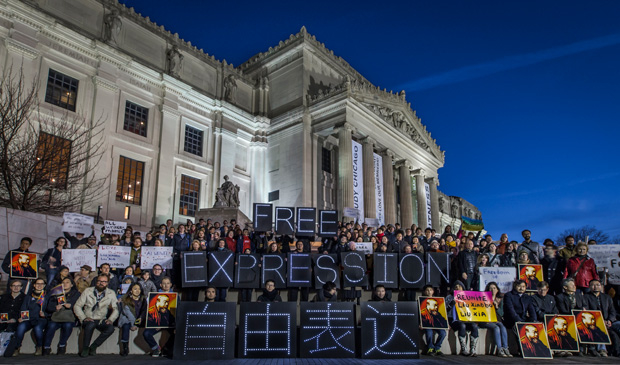Ai Weiwei retweeted me!” exclaimed a young blonde woman, laughing and waving her iPhone in the air with excitement. She and some two hundred other New Yorkers had gathered on the steps of the Brooklyn Public Library at Grand Army Plaza to show her solidarity with the iconic artist-activist currently under close government surveillance half a world away. Via social media, she told the world about her momentary connection to the aging enfant terrible of Chinese art using #withflowers—the same hashtag Ai employs to promote an ongoing art project outside his Beijing studio.
It was one of the first real spring days in New York, but it quickly got colder as the sun set over Prospect Park at the edge of Park Slope, a neighborhood flooded with artists back when Ai lived in New York City in the 1980s. Standing at a podium brought in for the occasion, rally organizers from the PEN American Center, a literary freedom advocacy group, read aloud works by dissidents who have been detained for challenging China’s one-party government: literary critic Liu Xiaobo (now serving eleven years in prison); his wife, the painter and poet Liu Xia (now under house arrest); and economist Ilham Tohti, who is awaiting trial on charges of separatism (a crime punishable by death). Earlier this month, PEN named Tohti the winner of its 2014 PEN/Barbara Goldsmith Freedom to Write Award.
The crowd gathered in Brooklyn a few evenings later, on April 10, was impeccably well behaved. There was no shouting, only polite applause as the readings finished. Several onlookers clutched handwritten signs calling for freedom of expression in China and for dissidents to be released. Others held up a portrait of Ai, the scar from a gash allegedly inflicted by Chinese policemen clearly visible on his head—the latest artwork from renowned Los Angeles street artist Shepard Fairey.
But Ilham Tohti and Liu Xiaobo, who won the Nobel Peace Prize in 2010 for non-violent struggle for human rights, were not household names to the Brooklyn crowd. Ai was the main attraction. As the rally moved down Eastern Parkway to the Brooklyn Museum—where the freedom-of-expression-themed art exhibition “Ai Weiwei: According to What?” opens April 17—some participants handcuffed their wrists together to show their solidarity. Rally organizers corralled nearly two hundred supporters onto the museum steps for a photograph they said they planned to Tweet to the artist. They lined up behind large placards reading “FREE EXPRESSION” in English and Chinese and raised their fists for the cameras. Ai retweeted my picture of the scene, too, as he did those taken by about thirty-five others present. He was virtually there.
A pop-cultural symbol for artistic freedom, resistance, and democracy, Ai is one of official Beijing’s most despised individuals. Yet he has become one of China’s most familiar trademarks abroad. As the country’s most iconic dissident and contemporary artist, Ai is perhaps the closest thing China’s civil society has to an official spokesperson.
“Freedom of expression is about encouraging every individual to question authority and to become more creative,” Ai told his New York supporters via a pre-recorded video. “So these are essential values for artists to protect and to fight for, and they will never come as a gift.”
This black and white projection onto an external wall of the museum is likely as close as Ai will get to New York any time soon. His passport was confiscated almost three years ago and his travel within China remains severely limited by the government. Ai has scheduled upcoming exhibitions in Berlin and at California’s infamous Alcatraz prison in San Francisco Bay. Without a passport, he can’t supervise installation in person nor be present for their openings. As the nearly-full moon rose, Ai’s video looped a few more times as the crowd dispersed into the night.
“I think in some ways he’s the most important artist in the world right now,” said Brooklyn-based artist Nicolas Benacerraf, twenty-seven, about Ai Weiwei. “He’s using many media of art to their fullest potential to communicate a socio-political message which has a deep beauty contained in it. So I support his work and many people like him struggling for free expression.”
Benacerraf said he was not ‘nearly as familiar’ with the other Chinese dissidents featured, but was confident that events like these could have an impact, especially if they had a digital dimension.
“I do believe that activism adds up over time and things reach critical mass, and even when things seem impossible they stand on the shoulders of these moments.”
Like many other participants, he had learned about the rally on social media.
Oscar Ramirez, a student in his twenties, left his work inside the library when his friends insisted he come out to see what was going on. He had only learned about Ai that night, but drew parallels with his home country of Venezuela.
“I like the idea,” Ramirez said. “These writers are in jail and have no freedom. Many countries, like Venezuela and many communist countries, are still not open to freedom.”

Retired writer Marilyn Moorcroft, seventy-one, teared up. “It makes me cry, that people suffer so much. I always babble so much with no consequences. It really upsets me how these writers are attacked for their work,” allowing, however, that she was only vaguely familiar with Ai’s art. Still, she had tried to persuade her friends from Greenwich Village, where she lives, to join her at the rally, but eventually travelled to Brooklyn alone. Originally from Iowa, Moorcroft said she grew up in a liberal climate. She held up a sign reading “Freedom for Chinese Writers + Artists.”
“Where is my passport?” asked another sign, this one held aloft by Hana Lee, forty, a Korean-American translator who said she was not really familiar with Ai’s confiscated travel documents, nor with the other dissidents whose causes were presented at the rally. But she knew their struggle: “For so many years, Korea had no freedom of speech,” she said. “It was similar to China.”
Still, there were almost no Chinese participants present. One exception was Wen Yunchao, a prominent Chinese dissident based in New York, who said he was surprised at how few of his countrymen showed up. Maybe it was a language barrier, he speculated, or maybe the Chinese just weren’t very interested in these issues. Wen held no illusion that the rally would change anything about the Chinese regime but was touched nonetheless. “We Chinese can do nothing,” he said, still hoping that the expressions of solidarity might inspire and support further actions. “We will not feel alone.”
That PEN’s rally organizers used Ai as a poster-boy for the cause of freedom of expression, hoping his name might help draw attention to other dissidents, did not bother Wen, who said he fears others such as Tohti will face life imprisonment or the death penalty. With the hope of getting Washington to pressure Beijing for Tohti’s release, the scholar’s daughter testified in front of the U.S. Congress last week.
While Ai is less well-known in China, he was received as a star in New York. Many at the rally had seen the documentary on his struggle Ai Weiwei: Never Sorry, or had heard of it. Several said they knew his art. Still, many sheepishly confessed that the signs they held were not by their own and had been handed to them by the organizers. Many weren’t too clear about the stories behind names on the signs they held.
Not everyone present believed the hype.
“Why has Ai Weiwei become such a movement?” asked Ariel Goldstein, thirty, a software salesman who was disappointed to find Ai’s art missing from the event. “I don't know, I really don't. I think it’s fairly arbitrary. He has the aesthetics and he’s a talented installations artist, but I don't think he’s the most talented, and I don’t think he has the most poignant ideas, not the most ground-breaking work.”
Others credited Ai’s skills in flirting with his Western audience, speaking to them in an irreverent language they might understand: dancing to South Korean pop star PSY’s “Gangnam Style,” painting Andy Warhol-esque Coca-Cola logos on two-thousand-year-old Chinese urns, and giving the finger to the portrait of Chairman Mao Zedong that hangs in Tiananmen Square.
Robert Suzuki, thirty-five, a self-described independent filmmaker, sees Ai’s art as possessing a more Western sensibility than work by his contemporaries. To an American audience, Suzuki argued, Ai’s cause is an easy sell: “The whole idea of political dissidence being oppressed is a big issue in the United States, but in China it takes on a dystopian, science-fictional Orwellian level.”
“Is he over-hyped? I don't know. There is no way for us to know,” Suzuki said. “But I think what shows with these artists—Ai Weiwei and the writers—is the fact that they’re put in jail for the slightest thing. What it shows the Western audience is the intolerance: it’s like a grown man kicking a four-year-old.”
It seemed natural that the focal point of the rally’s discussion of Beijing’s attempts to silence critics was Ai Weiwei.
“He’s always playing chess against the regime,” said Hugo Genes, twenty-five, a film student working with the non-profit organization that projected Ai’s video message—a message that reinforced the notion that China’s ruling party runs an obsolete, brutal, and unrefined government. “I think the Chinese regime is almost laughable right now. The kind of censorship they do is embarrassing, and it looks embarrassing to other parts of the world.”
Matt Klyse, twenty-three, an Art History student with a beard who wore a “FREE AI WEIWEI” pin on his jacket, was equally influenced by the Ai Weiwei effect: “It kind of makes you think about [the Chinese regime] because you usually only hear about it in the news: as a competitor to the U.S., as one of the great world powers just chugging on like everyone else,” he said. “But this makes you think of it a bit differently. How in some sense it is very different from portions of Europe and America where we do have these freedoms.”
While Klyse knew Ai well, he said he learned plenty new at the rally—about the Uighur and about Liu Xiaobo. Coming from the neighboring borough of Queens, he’d travelled—by New York City standards—rather far for the event.
Was it worth it? Would it make a difference?
After a moment’s hesitation, Klyse said: “It’s hard to say—it feels very far away in New York from a place like China, but you’d hope it’d have some effect. It’s nice to see that Ai Weiwei made a video.”




